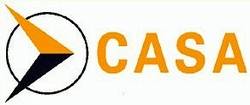Thu, Dec 04, 2003
AWB 27-4 Issue 1, 5 December 2003: Cessna 172, 180 and 185
Primary Flight Control Yoke Inspection
 Effectivity: Cessna
Aircraft Company and Reims Aviation (Cessna) 172, 180, and 185
series aircraft as listed in the current revision of Cessna Service
Bulletin SEB01-3.
Effectivity: Cessna
Aircraft Company and Reims Aviation (Cessna) 172, 180, and 185
series aircraft as listed in the current revision of Cessna Service
Bulletin SEB01-3.
Purpose: To alert operators and maintainers to
the potential failure of the welded steel tube yoke assembly, which
can result in loss of primary pitch control of the aircraft, and to
strongly recommend compliance with Cessna Service Bulletin SEB01-3.
This SB describes an inspection procedure to detect corrosion, and
determine the serviceability of a yoke that has suffered corrosion
pitting.
 Background: CASA and the
FAA have received defect reports describing extensive internal
corrosion initiated by moisture collecting inside the lower section
of the welded tubular structure. Some control yokes have suffered
structural failure due to corrosion in this zone.
Background: CASA and the
FAA have received defect reports describing extensive internal
corrosion initiated by moisture collecting inside the lower section
of the welded tubular structure. Some control yokes have suffered
structural failure due to corrosion in this zone.
The design of the control yoke in the nominated aircraft did not
have any provision to drain moisture from the lower section of the
yoke. This allowed moisture to collect inside the vertical tube of
the assembly, and initiate corrosion. In some cases the corrosion
caused a significant reduction of wall thickness of the yoke, and
resulted in failure of the lower elevator control lug.
Cessna Aircraft Company has issued instructions for an insitu
inspection of the control yoke, which requires an ultrasonic
inspection of the lower section of the yoke assembly. Yokes that
are corroded beyond the limits prescribed in SEB01-3 should be
replaced.
 In addition to this, CASA has
received a defect report describing internal corrosion deposits
outside the nominated area indicated in the Cessna SB, being
significantly higher up the vertical tube of the yoke than the
shaded area shown in Figure 1 of SEB01-3.
In addition to this, CASA has
received a defect report describing internal corrosion deposits
outside the nominated area indicated in the Cessna SB, being
significantly higher up the vertical tube of the yoke than the
shaded area shown in Figure 1 of SEB01-3.
Recommendation: CASA strongly recommends
operators and maintainers carry out the requirements of the current
revision of Cessna Service Bulletin SEB01-3, extending the zone of
eddy current inspection to match the extent of surface corrosion
detected, and incorporate the annual inspection requirements of
SEB01-3 into the aircraft maintenance program.
More News
Its Offerings Are Lighter, Cleaner, and Now Pushing Past 1,000nm on SAF Jet Fuel DeltaHawk’s diesel-powered aircraft lineup has seen incredible upgrades over the last few yea>[...]
The Airplane Experienced A Total Loss Of Engine Power On December 3, 2025, about 1600 central standard time, a Mooney Aircraft Corp. M20K, N57229, was substantially damaged when it>[...]
Make Sure You NEVER Miss A New Story From Aero-News Network Do you ever feel like you never see posts from a certain person or page on Facebook or Instagram? Here’s how you c>[...]
Aero Linx: European Society of Aerospace Medicine (ESAM) As a pan-European, independent forum, it works to promote the safety and health of all persons involved in aviation and spa>[...]
“We are excited to see Wisk achieve this milestone, and I’m so proud of the team that made it possible. The team at Wisk has built advanced technologies across flight c>[...]
 Aero-TV: DeltaHawks Diesel Power Steps Into the Spotlight
Aero-TV: DeltaHawks Diesel Power Steps Into the Spotlight NTSB Prelim: Mooney Aircraft Corp. M20K
NTSB Prelim: Mooney Aircraft Corp. M20K ANN FAQ: Turn On Post Notifications
ANN FAQ: Turn On Post Notifications ANN's Daily Aero-Linx (12.20.25)
ANN's Daily Aero-Linx (12.20.25) Aero-News: Quote of the Day (12.20.25)
Aero-News: Quote of the Day (12.20.25)





